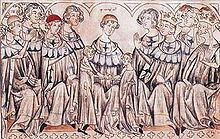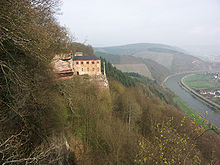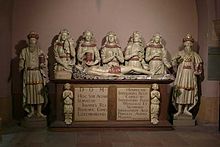- John of Bohemia
-
John of Bohemia King of Bohemia
John I, as Count of Luxemburg.Reign 1310–1346 Born August 10, 1296 Birthplace Paris ? Died August 26, 1346 Place of death near Crécy-en-Ponthieu Buried Kloster Altmünster ("Old-Minster Abbey") in Luxembourg Father Henry VII Mother Margaret of Brabant John the Blind (Luxembourgish: Jang de Blannen; German: Johann der Blinde von Luxemburg; Czech: Jan Lucemburský) (10 August 1296 – 26 August 1346) was the Count of Luxembourg from 1309 and King of Bohemia from 1310 and titular King of Poland. He was the eldest son of the Holy Roman Emperor Henry VII and his wife Margaret of Brabant. He is well known for having died while fighting in the Battle of Crécy at age 50, after having been blind for a decade.
Before he died in battle, he was reported to have said: "Let it never be the case that a Bohemian king runs [from a fight]!"
Contents
Life
Raised in Paris, John was French by education, but deeply involved in the politics of Germany. In 1310 his father arranged the marriage of the 14-year-old with Elisabeth from the Přemyslid dynasty, sister of the deceased King Wenceslaus III of Bohemia. John campaigned in Bohemia and was elected king by deposition of Henry of Carinthia, he thereby became one of the seven prince-electors of the Holy Roman Empire and - in succession of Wenceslaus III - claimant to the Polish and Hungarian throne. His attempts to follow his father as King of the Romans failed with the election of Louis IV of Wittelsbach in 1314. He later would support Louis in his rivalry with Frederick the Fair of Habsburg, culminating in the 1322 Battle of Mühldorf and in return he received the Egerland as a reward.
 John's wedding with Elisabeth of Bohemia at Speyer
John's wedding with Elisabeth of Bohemia at Speyer
Like his predecessor Henry, he was disliked by much of the Czech nobility. John was considered to be an "alien king" and soon gave up the administration of Bohemia and embarked on a life of travel, spending time in Luxembourg and the French court. His travels took him to Silesia, Poland, Lithuania, Tyrol, Northern Italy and Papal Avignon. A rival of King Władysław I the Elbow-high to the Polish crown, John supported the Teutonic Knights in the Polish–Teutonic War from 1326 to 1332. He also made several Silesian dukes swear an oath of allegiance to him. In 1335 in Congress of Visegrád, Władysław's successor King Casimir III the Great of Poland paid a significant amount of money in exchange for John's giving up his claim to the Polish throne.[1]
John lost his eyesight at age 39 or 40 from ophthalmia in 1336, while crusading in Lithuania. A treatment by the famous physician Guy de Chauliac had no positive effects. At the outbreak of the Hundred Years' War in 1337 he allied with King Philip VI of France and even was governor of Languedoc from 30 November 1338 to November 1340. He was killed at age 50 in 1346, while fighting alongside the French against the English at the Battle of Crécy. The medieval chronicler Jean Froissart left the following account of John's last actions:
...for all that he was nigh blind, when he understood the order of the battle, he said to them about him: 'Where is the lord Charles my son?' His men said: 'Sir, we cannot tell; we think he be fighting.' Then he said: 'Sirs, ye are my men, my companions and friends in this journey: I require you bring me so far forward, that I may strike one stroke with my sword.' They said they would do his commandment, and to the intent that they should not lose him in the press, they tied all their reins of their bridles each to other and set the king before to accomplish his desire, and so they went on their enemies. The lord Charles of Bohemia his son, who wrote himself king of Almaine and bare the arms, he came in good order to the battle; but when he saw that the matter went awry on their party, he departed, I cannot tell you which way. The king his father was so far forward that he strake a stroke with his sword, yea and more than four, and fought valiantly and so did his company; and they adventured themselves so forward, that they were there all slain, and the next day they were found in the place about the king, and all their horses tied each to other.
After the battle, legend states that John's personal crest (a pair of black wings) and motto Ich dien ("I Serve") were adopted in slightly modified form by Edward, the Black Prince, and since then they have been part of the badge of the Prince of Wales.
John was succeeded as King of Bohemia by his eldest son Charles (later Charles IV, Holy Roman Emperor). In Luxembourg, he was succeeded by his son by his second wife, Wenceslaus.
The manner of his death gave rise to the obsolescent idiom, "to fight like King John of Bohemia", meaning "to fight blindly".[citation needed]
Funeral
The body of John the Blind was moved to Kloster Altmünster ("Old-Minster Abbey") in Luxembourg. When the abbey was destroyed in 1543 the corpse was moved to Kloster Neumünster ("New-Minster Abbey") in Luxembourg. During the confusion of the French Revolution the mortal remains were salvaged by the Boch industrialist family (founders of Villeroy & Boch, ennobled in 1892) and hidden in an attic room in Mettlach on the Saar River. The legend has it that the monks of the abbey asked Pierre-Joseph Boch for this favor.
His son Jean-François Boch met with Prince Frederick William of Prussia on his voyage through the Rhineland in 1833 offering the remains as a gift. As Prince Frederick considered John the Blind to be one of his ancestors he ordered Karl Friedrich Schinkel to construct a funeral chapel. The chapel was built in 1834 and 1835 near Kastel-Staadt on a rock above the town. In 1838 on the anniversary of his death John the Blind was laid in a black marble Sarcophagus in a public ceremony.
In 1945 the Luxembourg government took the chance to obtain possession of the bones. In a cloak and dagger operation the remains were moved to the crypt of the Notre-Dame Cathedral, Luxembourg. The tomb reads "d.o.m., hoc sub altari servatur ioannes, rex bohemiæ, comes luxemburgensis, henrici vii imperatoris filius, caroli iv imperatoris pater, wenceslai et sigismundi imperatorum avus, princeps animo maximus orbiit mmcccxl 30 au."
Quotes
According to the Cronica ecclesiae pragensis benesii krabice de weitmile, before he died at the Battle of Crécy, he said: "With God's help it will never be that a Bohemian king would run from a fight!"
Family and children
He was married twice:
First, to Elisabeth of Bohemia (1292–1330). In this marriage he had the following children:
- Margaret of Bohemia (8 July 1313–11 July 1341, Prague), married in Straubing 12 August 1328 to Henry XIV, Duke of Bavaria.
- Bonne (21 May 1315–11 September 1349, Maubuisson), married in Melun 6 August 1332 to King John II of France.
- Charles IV (14 May 1316–29 November 1378), King of Bohemia and Holy Roman Emperor.
- Ottokar ("Otto") (22 November 1318–20 April 1320), Prince of Bohemia.
- John Henry (Jan Jindřich) (12 February 1322, Mělník–12 November 1375), Margrave of Moravia.
- Anna (1323–3 September 1338), twin of Elizabeth, married 16 February 1335 to Otto, Duke of Austria.
- Elizabeth (1323–1324), twin of Anna.
Second (December 1334), to Beatrice of Bourbon, daughter of Louis I, Duke of Bourbon. This marriage produced one son:
- Wenceslaus I of Luxembourg (25 February 1337 - 7 December 1383), Duke of Luxembourg and Brabant.
His illegitimate son Nicolaus was Patriarch of Aquileia from 1350 to 1358.
Genealogy
Ancestors of John of Bohemia 16. Waleran III of Limburg 8. Henry V, Count of Luxembourg 17. Ermesinde, Countess of Luxembourg 4. Henry VI, Count of Luxembourg 18. Henry II of Bar 9. Margaret of Bar 19. Philippa of Dreux 2. Henry VII, Holy Roman Emperor 20. Bouchard IV of Avesnes 10. Baldwin of Avesnes 21. Margaret II, Countess of Flanders 5. Beatrice d'Avesnes 22. Thomas II of Coucy 11. Félicité of Coucy 23. Mahaut of Rethel 1. John of Bohemia 24. Henry II, Duke of Brabant 12. Henry III, Duke of Brabant 25. Marie of Hohenstaufen 6. John I, Duke of Brabant 26. Hugh IV, Duke of Burgundy 13. Adelaide of Burgundy 27. Yolande of Dreux 3. Margaret of Brabant 28. William II of Dampierre 14. Guy of Dampierre 29. Margaret II, Countess of Flanders (= 21.) 7. Margaret of Flanders 30. Robert VII of Bethune 15. Matilda of Bethune 31. Isabel of Mori References
- ^ Nowakowski Tomasz Tadeusz: Kazimierz Wielki a Bydgoszcz. Toruń: Wydawnictwo Adam Marszałek, 2003. ISBN 83-7322-527-7. , pp. 73-74, 76, 79, 83, 165-171, 176
- The Chronicles of Froissart, translated by Lord Berners, edited by G.C. Macaulay. The Harvard Classics. [1]
- CRONICA ECCLESIAE PRAGENSIS BENESSII KRABICE DE WEITMILE [2]
External links
John of BohemiaBorn: 10 August 1296 Died: 26 August 1346Preceded by
Henry of CarinthiaKing of Bohemia
1310–1346Succeeded by
Charles IVPreceded by
Henry VIICount of Luxembourg
1313–1346Monarchs of Bohemia Přemyslid c.870–1306- Bořivoj I
- Spytihněv I
- Vratislaus I
- Wenceslaus I
- Boleslaus I
- Boleslaus II
- Boleslaus III
- Vladivoj
- Boleslaus III
- Boleslaus the Brave1
- Jaromír
- Ulrich
- Jaromír
- Ulrich
- Bretislaus I
- Spytihněv II
- Vratislaus II
- Conrad I
- Bretislaus II
- Bořivoj II
- Svatopluk
- Vladislaus I
- Bořivoj II
- Vladislaus I
- Sobeslaus I
- Vladislaus II
- Frederick
- Sobeslaus II
- Bedřich
- Conrad II
- Wenceslaus II
- Ottokar I
- Bretislaus III
- Vladislaus III
- Ottokar I 2
- Wenceslaus I
- Ottokar II
- Wenceslaus II
- Wenceslaus III
Non-dynastic 1306–1310- Henry the Carinthian
- Rudolph I
- Henry the Carinthian
Luxembourg 1310–1437- John the Blind
- Charles I
- Wenceslaus IV
- Sigismund
Habsburg 1437–1457- Albert
- Interregnum
- Ladislaus the Posthumous
Non-dynastic 1457–1471Jagiellon 1471–1526- Vladislaus II
- Louis
Habsburg 1526–1780Habsburg-Lorraine 1780–1918- 1 Also duke of Poland from the Piast dynasty.
- 2 Hereditary kings since 1198.
- 3 Antiking.
Monarchs of Luxembourg Counts of Luxembourg (963–1354) Elder House of Luxembourg
(963–1136) House of Namur
House of Namur
(1136–1189)- Henry IV (1136–1189)
House of Hohenstaufen
(1196–1197)- Otto (1196–1197)
House of Namur
(1197–1247)House of Limburg
(1247–1354)- Henry V (1247–1281)
- Henry VI (1281–1288)
- Henry VII (1288–1313)
- John I (1313–1346)
- Charles I (1346–1353)
- Wenceslaus I (1353–1354)
Dukes of Luxembourg (1354–1794) House of Limburg
(1354–1443)- Wenceslaus I (1354–1383)
- Wenceslaus II (1383–1388)
- Jobst (1388–1411)
- Elisabeth (1411–1443) with
- Anthony (1411–1415), and then
- John II (1418–1425)
 House of Valois-Burgundy
House of Valois-Burgundy
(1443–1482)- Philip I (1443–1467)
- Charles II (1467–1477)
- Mary I (1477–1482) and
- Maximilian I (1477–1482)
House of Habsburg
(1482–1700)- Philip II (1482–1506)
- Charles III (1506–1556)
- Philip III (1556–1598)
- Isabella Clara Eugenia (1598–1621) and Albert (1598–1621)
- Philip IV (1621–1665)
- Charles IV (1665–1700)
House of Bourbon
(1700–1712)- Philip V (1700–1712)
House of Wittelsbach
(1712–1713)- Maximilian II (1712–1713)
House of Habsburg
(1713–1780)House of Habsburg-Lorraine
(1780–1794)Grand Dukes of Luxembourg (since 1815) House of Orange-Nassau
(1815–1890)- William I (1815–1840)
- William II (1840–1849)
- William III (1849–1890)
 House of Nassau-Weilburg
House of Nassau-Weilburg
(since 1890)- Adolphe (1890–1905)
- William IV (1905–1912)
- Marie-Adélaïde (1912–1919)
- Charlotte (1919–1964)
- Jean (1964–2000)
- Henri (since 2000)
Categories:- 1296 births
- 1346 deaths
- 14th-century Luxembourgian people
- 14th-century Czech people
- Medieval child rulers
- Bohemian monarchs
- Roman Catholic monarchs
- Counts of Luxembourg
- Luxembourgian dynasty
- People of the Northern Crusades
- Luxembourgian people of Belgian descent
- Luxembourgian people of Dutch descent
- Luxembourgian expatriates in France
- Czech people of Luxembourgian descent
- Czech people of Belgian descent
- Czech people of Dutch descent
- People from Paris
- Monarchs killed in action
- Burials at Notre-Dame Cathedral, Luxembourg
- Blind people
Wikimedia Foundation. 2010.




